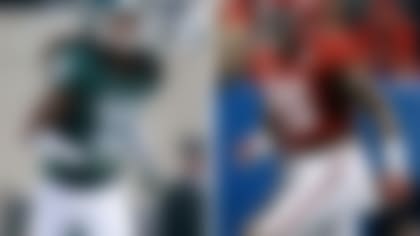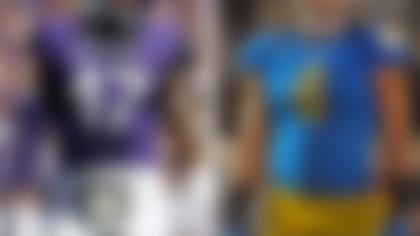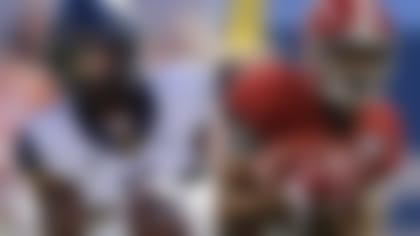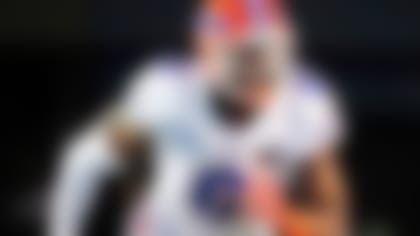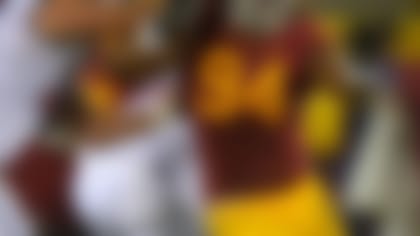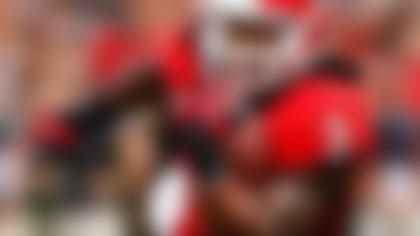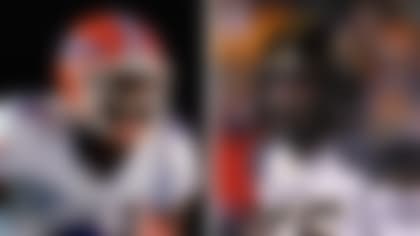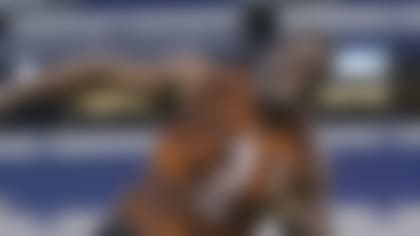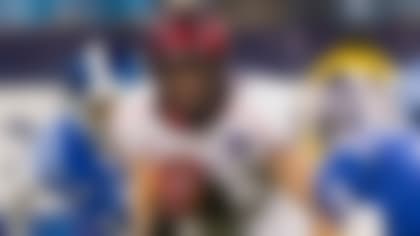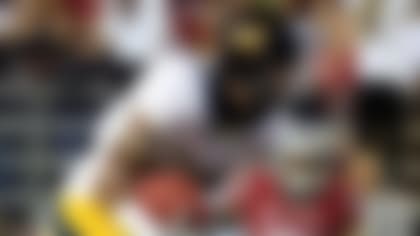Positional overviews: QBs | RBs | Interior DLs | Edge rushers | WRs/TEs
We continue our quick-hit position overviews for the 2015 NFL Draft with offensive linemen.
There has been at least one offensive lineman taken in the top 10 in each of the past nine drafts, with a combined six going in the top 10 in the past two drafts. One of the storylines in the 2015 draft will be whether any offensive lineman goes in the top 10.
There have been a total of 32 O-linemen selected in the first round of the past five drafts, with 22 of those being tackles. There also have been seven guards and three centers. (All five linemen who went in the first round last year were tackles.) There is no consensus top lineman in this draft, even among NFL Media analysts. Perhaps the biggest name is Iowa's Brandon Scherff, a college tackle who could move to guard in the NFL.
Here's a quickie look at offensive linemen in this draft, first at tackle, then in the interior.
Offensive tackle
Teams with greatest need (in draft order): Washington (picks 5th), New York Giants (9th), Minnesota (11th), San Diego (17th), Kansas City (18th), Detroit (23rd), Carolina (25th), Denver (28th).
Mike Mayock's top 5 at the position: 1. LSU's La'el Collins; 2. Miami's Ereck Flowers; 3. Florida's D.J. Humphries; 4. Stanford's Andrus Peat; T-5. Pittsburgh's T.J. Clemmings; T-5. Texas A&M's Cedric Ogbuehi.
Biggest upside: Florida's D.J. Humphries. Humphries is a former national top-10 recruit in the 2012 recruiting class who battled injury issues and inconsistency as a Gator. He played in 29 games in three seasons, starting 19, and has had ankle and knee problems. So why is he considered a first-round pick? Humphries (6-foot-5, 309 pounds) is one of the best athletes among the linemen in this draft class and definitely has the needed measurables to thrive in the NFL. He needs to become more consistent with his technique; forget looking good from game-to-game -- he had issues from series-to-series with the Gators. He played in the 290s at Florida, and the added weight in the run-up to the draft is a plus; he has not lost any of his quickness and looks as if he could handle even more weight if needed. He can be a physical run blocker, and once he develops some consistency, he has a high ceiling because of his athleticism and movement skills.
Most underrated: Wisconsin's Rob Havenstein. As with almost every Badgers offensive lineman, Havenstein (6-7, 328) is a huge man. A huge man. He is strictly a right tackle, but he can be a devastating run blocker; once he locks on, the defender is doomed -- and frequently ends up on his backside. Havenstein has surprisingly good feet; he played lacrosse as well as football and basketball in high school in the Baltimore area, and his twin brother was a starting basketball player at Longwood. He can become better in pass protection, but that's the case with almost every lineman who arrives in the NFL. His size, toughness and run-blocking ability mean he will get the needed time to develop as a pass protector.
Most overrated: Colorado State's Ty Sambrailo. Sambrailo is not a bad player, by any means. His is simply a case of a player being called "underrated" for so long that he's actually a bit overrated now. There is a lot to like, but there also are facets of his game that deserve criticism. Sambrailo (6-6, 311) has impressive size and is athletic, but there is a concern about his strength -- both against bull rushers and in the run game. He played left tackle for the Rams, who had a productive pro-style offense, but there are concerns with whether Sambrailo can play left tackle in the NFL. Right tackle or even guard might be his best position.
Biggest sleeper: Notre Dame College's Doniel Gambrell. Gambrell (6-6, 315) played at a Division II school in Euclid, Ohio, a Cleveland suburb. Gambrell is from powerhouse Cleveland Glenville (he played with Ohio State QB Cardale Jones and Michigan DE Frank Clark, among others, in high school). Gambrell is a good athlete for a man his size, and while he could move inside to guard, he looks to have the needed athleticism to play tackle in the NFL. Gambrell has the desired measurables, including long arms, but must add strength and bulk. He is raw and needs seasoning, but the pay-off could be a nice-sized one.
Better pro than college player: Pittsburgh's T.J. Clemmings. Clemmings was being mentioned as a potential top-15 pick going into the Reese's Senior Bowl, but while that's not going to happen, he still is seen as a likely first-rounder. Clemmings (6-5, 309) has played just two seasons along the offensive line (he moved over from defense), and those two seasons came at right tackle. He looks to have the skill set to eventually play left tackle, but he remains relatively raw for a potential first-round lineman. Still, the upside is there, and the belief is that as he continues to learn how to play the position, he can develop into a star tackle -- and maybe even on the left side.
Top small-school prospect: Eastern Washington's Jake Rodgers. (Rodgers and Gambrell have drawn the same grade from NFL Media analyst Lance Zierlein, and since we already talked about Gambrell, we'll use this space to talk about Rodgers.) Rodgers (6-6, 320) played his college ball on Roos Field at EWU; the field was named in honor of former EWU OT Michael Roos, who donated a lot of money to the school, and Rodgers is trying to become the first EWU lineman drafted since Roos went in the second round to the Tennessee Titans in 2005. Rodgers began his career at Washington State and started all 12 games for the Cougars as a sophomore in 2012 -- eight at tackle and four at guard. But he transferred to EWU in the summer of 2013 and settled in at right tackle. He missed five games in '13 with a knee injury. He has good size and athleticism (he was a tight end and a solid basketball player in high school), but must become more consistent.
First-round grades (in order): Peat, Humphries, Collins, Clemmings, Flowers and Ogbuehi.
Interior linemen
Teams with greatest need (in draft order): Atlanta (8th), St. Louis (10th), New Orleans (13th and 31st), Miami (14th), Houston (16th), Kansas City (18th), New England (32nd), Seattle (63rd).
Mike Mayock's top 5 at the position: 1. Iowa G Brandon Scherff; 2. Florida State C Cameron Erving; 3. Duke G Laken Tomlinson; 4. South Carolina G A.J. Cann; 5. Florida State G Tre' Jackson.
Biggest upside: Iowa's Brandon Scherff. Scherff (6-5, 319) was perhaps the most highly touted offensive lineman entering the 2014 college season, and he played at a high level. Still, while he was a star left tackle for the Hawkeyes, the feeling seems to be that he fits best as a guard in the NFL -- as in a potential Pro Bowl guard. Scherff is freakishly strong and plays with a mean streak -- a nasty streak, actually; those traits obviously would serve him well as an interior lineman. His pass-protection skills are not as advanced as his run-blocking ability, and while no one questions his work ethic in terms of trying to improve, he seems to have a higher upside inside. He is powerful and tough, and has the potential to become a massive road-grader in the NFL. It wouldn't be a surprise if he is the only interior lineman to go in the first round.
Most underrated: Missouri's Mitch Morse. Morse spent his last two seasons at Mizzou as the Tigers' starting right tackle, but seems likely to transition inside in the NFL. He has some experience inside, as he started seven games at center as a sophomore in 2012. Guard is his best NFL fit, though. Morse (6-5, 305) is a tough, physical guy who has drawn some comparisons to Cleveland Browns guard Joel Bitonio, who started at left tackle for Nevada but moved inside and played at a high level as a rookie last season. Morse is limited athletically, but his run-blocking ability stands out and makes him a good fit at guard.
Most overrated: Utah's Jeremiah Poutasi. Poutasi (6-5, 335) has impressive size, but looks to lack the needed athleticism to play tackle, his college position, at the next level. Thus, a move to guard seems likely. Can he make the move? No one doubts his strength once he gets into a defender. But he must become a consistent drive blocker and use his size and strength to his advantage. Again, his size is a big selling point -- figuratively and literally. But he could struggle for a while when/if he moves inside. He left Utah after his junior year and would've been best-served by staying for his senior season.
Biggest sleeper: Georgia Tech's Shaq Mason. Mason was a three-year starting guard at Georgia Tech who earned some All-ACC acclaim, but wasn't invited to the combine. He is a squatty guy (6-1, 300) who could move to center in the pros. He is strong and a good run blocker, and is adept at getting to the next level when he pulls. He wasn't asked to do all that much in pass protection. Still, teams that employ a power-running attack will be intrigued by Mason, who likely goes on the third day but has the ability to be a starter. It appears his parents were basketball fans: His full name is Shaquille Olajuwon Mason.
Better pro than college player: Kentucky's Darrian Miller. Miller (6-5, 307) was a three-year starter at left tackle at Kentucky, but he's another prospect who appears best-suited to play inside at the next level. A move inside could help him realize his potential. He was one of the slowest linemen at the combine (5.52 in the 40), and his lack of athleticism means he would have trouble at tackle in the NFL. He is a try-hard guy who must become a better drive blocker. But he certainly has the size to be a solid NFL guard.
Top small-school prospect: Hobart's Ali Marpet. Marpet played tackle for Division III Hobart, but will slide inside -- to either center or guard -- in the NFL. Marpet (6-4, 307) was a curiosity of sorts until the Senior Bowl, where he proved he belonged; he also had a strong combine, turning in a 4.98 clocking in the 40 that was the fastest of any lineman at the event. Marpet is athletic and strong, and has impressive first-step quickness. There is going to be a learning curve: The first time he blocked NFL-caliber players was at the Senior Bowl, and he also will be playing a new position. Still, he will be just the 11th D-3 player drafted this century and the first since 2012.
First-round grades (in order): Scherff. That's it.
Mike Huguenin can be reached at mike.huguenin@nfl.com. You also can follow him on Twitter @MikeHuguenin.
